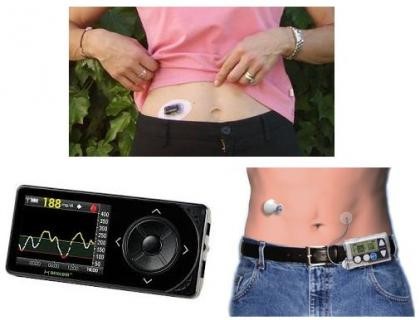- Home
- Our Services
- Continuous Glucose Monitoring (CGM)
What is involved in CGM?
Continuous glucose monitoring (CGM) involves wearing a small glucose sensor inserted in the subcutaneous (fatty tissue) layer under the skin, usually in the abdomen or upper, outer flank/ buttock.
The sensor measures glucose every 5 minutes and is normally worn for a 6 day period. Once complete, the data is uploaded and plotted onto graphs, enabling identification of glucose patterns.
Do I need CGM?
CGM may be recommended by your doctor if you are experiencing fluctuations or concerning trends in your blood glucose levels, especially overnight.
CGM can be offered to people using insulin pumps as well as to those on multiple daily injections, including people with type 1 or type 2 diabetes.
CGM can be a very valuable tool for both you and your diabetes team to see a big picture of what is happening with your diabetes. CGM can shed light on factors that influence your glucose levels to guide day-to-day decisions and adjustments in your management.
Types of CGM
There are two types of CGM:
- Real-time (glucose data seen on a small screen device as it is happening)
- Retrospective (glucose data is recorded and looked at after the study is finished)
There are systems available that can work on their own and those that talk to some insulin pumps.
You and your diabetes team will decide on the best type of CGM system for your needs.
Insertion of the sensor and device training
If your doctor has referred you for CGM, you will have to sign consent forms to have the investigation and will be asked to sign admission paperwork.
You will receive the following appointments:
- An admission appointment for sensor insertion and device training
- An admission appointment for sensor removal and data uploading
- BH outpatient Diabetes Clinic appointment to review the CGM data with your referring doctor or an endocrinologist.
Please allow up to 2 hours for appointments. A medical certificate can be provided at your request.
What does the investigation cost?
You will be admitted as a public day-stay inpatient for both the insertion and the removal of your CGM sensor. There is no fee for the investigation.
Wearing the device
During your training you will be advised on how often you will need to ‘calibrate’ with fingerprick blood glucose tests. Calibration of the device is required to ensure accuracy of the results.
You will also be advised what activities you will need to record/log while wearing the device. Your CGM sensor and transmitter is completely waterproof. You may swim, shower, exercise and engage in other daily activities as usual. In fact, we strongly encourage you to follow your normal routine so that the data provides a true reflection of your blood glucose levels on a day-to-day basis.
Following completion of your initial sensor insertion and training, you will be discharged home wearing the CGM for 24 hours a day for the duration of the investigation. Depending on the type of sensor used; you will wear the device for 6 - 7 days, and then return for your sensor removal. Your data will then be uploaded and reviewed together with you by a diabetes educator and your referring doctor or endocrinologist.
Your results will be discussed with you during your next outpatient appointment in the diabetes clinic.
How to access this service
For investigation and training, you will need a referral from your Bendigo Health Endocrinologist and to be admitted to Bendigo Health as a public day patient. Please speak to your doctor or diabetes educator for more information.

